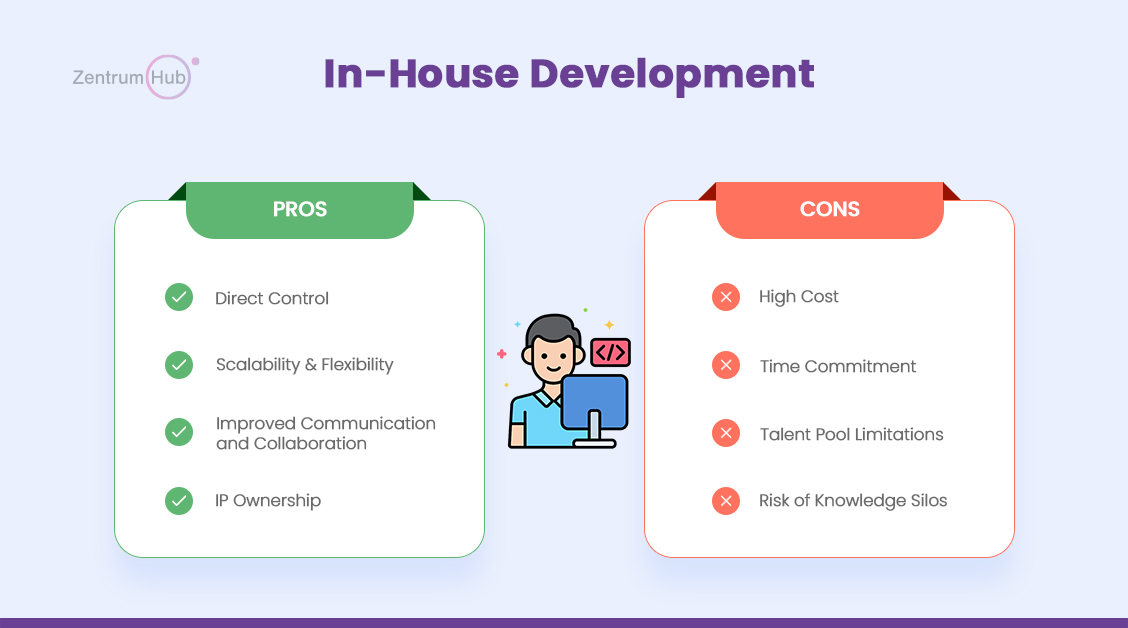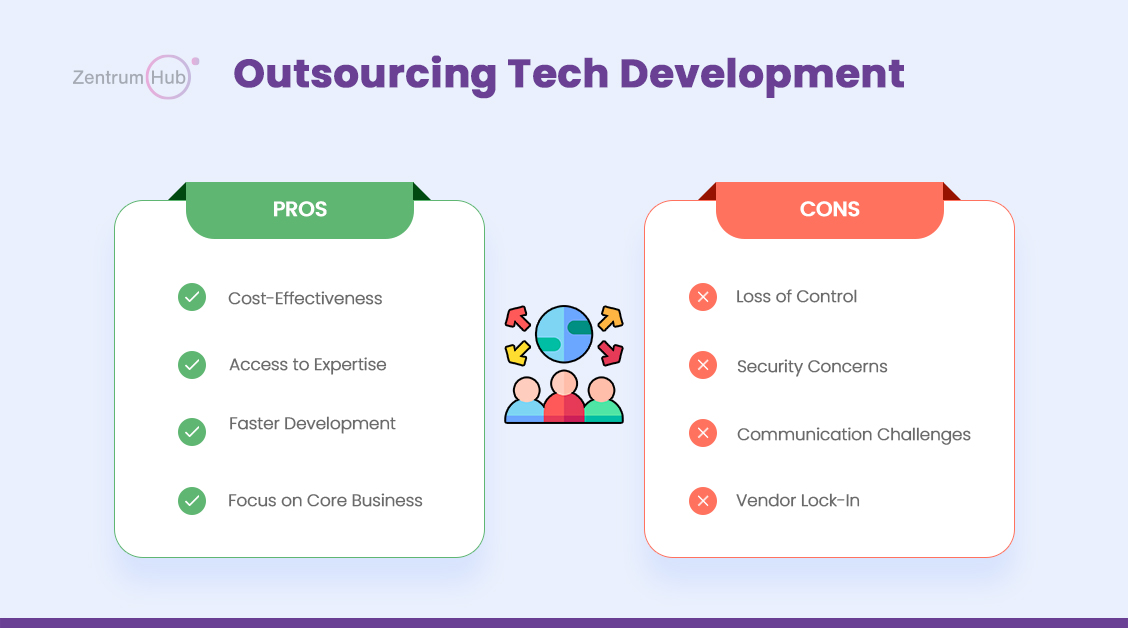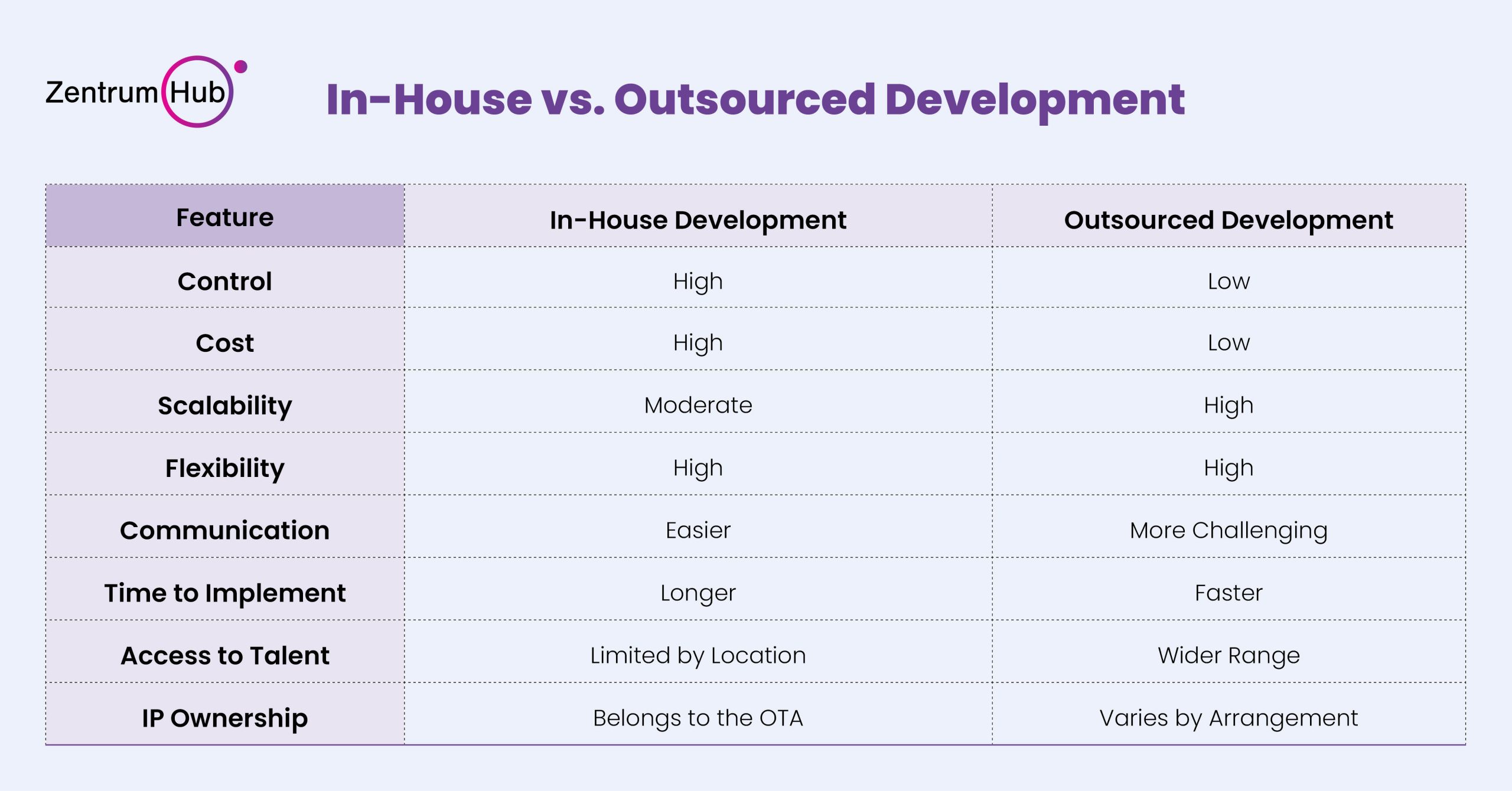For Online Travel Agencies (OTAs), technology is the lifeblood. It powers everything from search functionalities and booking systems to customer interactions and data analysis. Choosing the right approach to tech solutions, however, can be a complex decision. OTAs must weigh the merits of building an in-house tech team against outsourcing development to a third-party vendor.
This blog will explore the advantages and disadvantages of both in-house and outsourced tech solutions, helping OTAs navigate the best path for their specific needs.

Having an in-house tech team offers OTAs a high degree of control over their technology stack. Here’s a breakdown of the pros and cons:
Pros:
Direct Control: An in-house team allows for close collaboration between developers and product managers. This fosters a deep understanding of the OTA’s business goals and enables the creation of custom-tailored solutions that perfectly align with those goals.
Scalability and Flexibility: In-house teams can be scaled up or down as needed. They can also adapt quickly to changing market demands and technological advancements.
Improved Communication and Collaboration: Daily interaction with developers fosters a strong understanding of the project’s vision and facilitates streamlined communication. This can lead to faster development cycles and fewer roadblocks.
IP Ownership: Intellectual property (IP) rights for any developed technology remain with the OTA. This can be crucial for OTAs with unique features or functionalities that give them a competitive edge.
Cons:
High Cost: Building and maintaining an in-house tech team is expensive. It requires not only salaries and benefits for developers but also infrastructure costs for equipment, office space, and software licenses.
Time Commitment: Recruiting, training, and managing a qualified in-house team takes considerable time and resources. This can delay project timelines and hinder the OTA’s ability to adapt to rapidly evolving technological landscapes.
Talent Pool Limitations: Depending on the OTA’s location, finding and retaining top-tier tech talent can be challenging. This can limit the team’s capabilities and hinder innovation.
Risk of Knowledge Silos: In-house teams can become isolated, leading to knowledge silos and a lack of diverse perspectives.

Outsourcing tech development involves partnering with a specialized company to handle some or all OTAs technology needs. Here’s a closer look at the pros and cons:
Pros:
Cost-Effectiveness: Outsourcing is typically cheaper than building and maintaining an in-house team. OTAs pay only for the services they need, eliminating the need for fixed costs associated with salaries, benefits, and infrastructure.
Access to Expertise: Outsourcing vendors have access to a pool of experienced developers with diverse skillsets. This allows OTAs to leverage expertise that might not be readily available in-house.
Faster Development: Outsourcing vendors often have established development processes and can complete projects more quickly than building an in-house team from scratch.
Focus on Core Business: Outsourcing frees up internal resources to focus on core business functions like marketing and customer service.
Cons:
Loss of Control: OTAs relinquish some control over the development process when outsourcing. Clear communication and a well-defined project scope are essential to ensure the final product meets expectations.
Security Concerns: Sharing sensitive data with a third-party vendor can raise security concerns. It’s crucial to choose an outsourcing partner with a strong track record of data security.
Communication Challenges: Effective communication can be more challenging with outsourced teams, especially if there are time zone differences or language barriers.
Vendor Lock-In: Switching outsourcing vendors can be disruptive and expensive, especially for complex projects.

The decision between in-house and outsourced development hinges on several factors specific to each OTA. Here are some key considerations:
Size and Budget: Larger OTAs with substantial budgets may find in-house development more manageable. Smaller OTAs or those with tighter budgets might benefit more from outsourcing.
Project Scope and Complexity: For simple, well-defined projects, outsourcing can be a good option. Complex projects requiring ongoing maintenance might be better suited for an in-house team.
Technical Expertise: If the OTA has a strong internal tech team with the necessary skills, in-house development might be the way to go. If expertise is lacking, outsourcing can provide access to the required talent.
Speed and Time to Market: For projects requiring a fast turnaround, outsourcing can be advantageous. However, for projects with a longer development timeline, building an in-house team might provide more control.
Many OTAs opt for a hybrid approach, leveraging the strengths of both in-house and outsourced development. For example, an OTA might maintain a core in-house team for critical projects and strategic initiatives, while outsourcing non-core functionalities or routine maintenance tasks.
This hybrid approach offers flexibility and cost-effectiveness. It allows OTAs to scale their development efforts up or down as needed and access specialized expertise when required.
There’s no one-size-fits-all answer to the in-house vs. outsourced development question. The optimal approach depends on the unique circumstances of each OTA. By carefully considering the factors mentioned above, OTAs can make an informed decision that aligns with their specific needs and goals.
Having a clear understanding of the project’s goals, functionalities, and target audience is essential for success. Open and consistent communication is crucial, especially when working with outsourced vendors. Be realistic about timelines, budgets, and resource requirements. Rigorous testing is essential to ensure the quality and functionality of the developed solution.
By carefully evaluating their needs and implementing best practices, OTAs can leverage technology to achieve their business objectives and gain a competitive edge in the ever-evolving travel industry.
We use cookies to ensure that we give you the best experience on our website. If you continue to use this site we will assume that you are happy with it.
